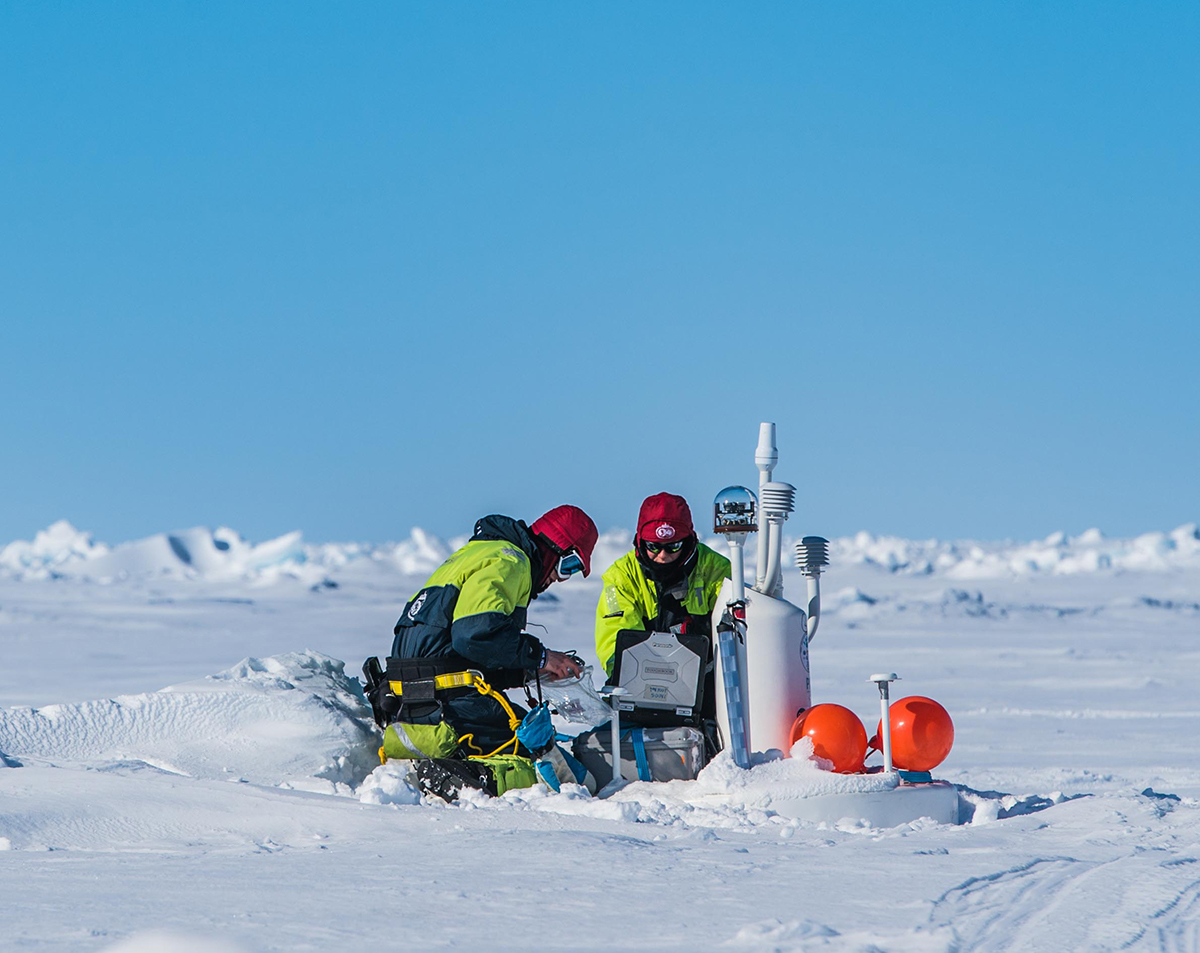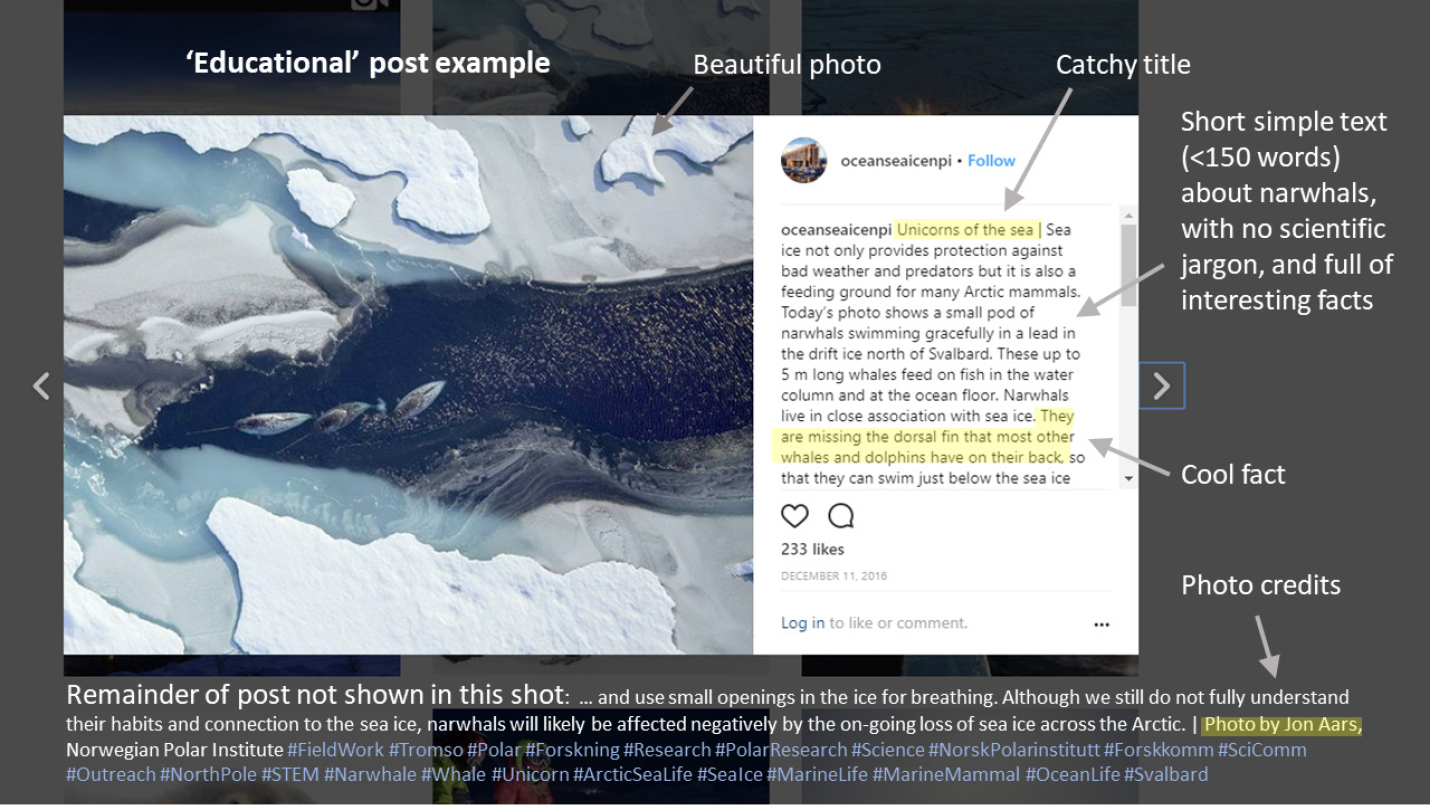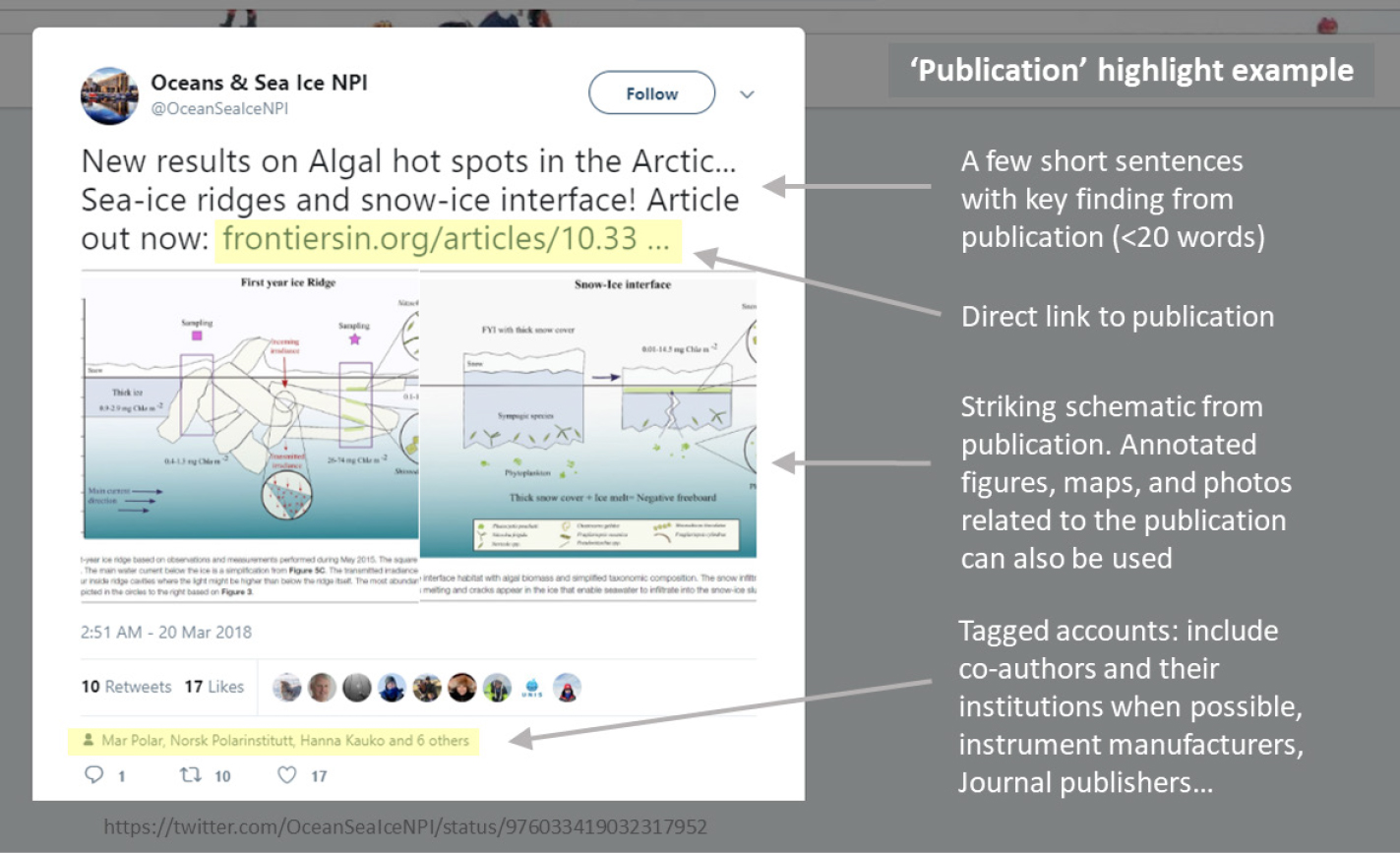Communication is a key aspect of a scientist’s work. Part of our mandate is to communicate findings not only to the research community, through peer-reviewed articles, but also to the wider public. Raising awareness of how science serves the public is becoming increasingly important. There are few incentives, and generally negligible financial support, for scientists to communicate with the general public. @oceanseaicenpi is an initiative led by a small team of researchers who are exploring the use of social media for science outreach. Over the past four years, @oceanseaicenpi has built a global audience of more than 7,000 followers, successfully sharing knowledge and findings in polar oceanography and related disciplines. By presenting the benefits and sharing advice on how to create and run social media accounts for science outreach, we hope to inspire research groups, individual researchers, and institutions to further engage in science communication using social media.
|
|
SOCIAL MEDIA AND SCIENCE OUTREACH
Since the beginning of this century, the number of social media platforms, media-sharing sites, and blogging platforms has soared to include millions and billions of users. These social media platforms provide great opportunities for professional science communicators, individual researchers, and research teams to connect with the general public (Bik and Goldstein, 2013).
Social media was originally designed for global social networking and information sharing. Large academic institutions quickly recognized the potential of using social media platforms to connect with student communities at universities. Individual researchers are now also using social media platforms (e.g., Twitter) to accomplish academic objectives such as professional networking and science communication (Hemmi et al., 2009; Veletsianos, 2012). However, research groups are still underrepresented on social media (Pavlov et al., 2018). This can be partly explained by the difficulty researchers may encounter in trying to convince their leaders to use social media for science outreach. Many senior researchers do not use or understand social media well, struggle to see associated benefits, and think it should be left to professional science communicators. Yet the perception that social media should not be part of the life of scientists is changing. For example, the oceanography community has a small but strong presence on the Instagram platform, composed of institutes, associations, small research groups, and large universities (Box 1).
Social media comes in many types and flavors. While popular platforms such as Facebook, Instagram, and Twitter can connect researchers with the global public, academic and professional social media platforms such as ResearchGate, Google Scholar, and LinkedIn allow scientists to network, collaborate, and share their work globally. Here, we present @oceanseaicenpi, the successful social media initiative of our Oceans and Sea Ice research group at the Norwegian Polar Institute in Tromsø, Norway. Using several social media platforms, we use @oceaseaicenpi to communicate science, educate the public, and develop networks with the professional community. Based on four years of experience, we provide advice for research groups on how to create and run social media accounts for outreach to the wider public. By articulating the “why” and “what’s in it for us,” we also provide readers with a context for discussion among their own research teams.
|
@OCEANSEAICENPI: FOUR YEARS OF EXPERIENCE
The Oceans and Sea Ice team is an interdisciplinary group of 15 to 20 oceanographers, sea ice scientists, and atmospheric scientists who work in the Arctic and Antarctic regions. The team decided in early 2014 to start using social media as a tool for science outreach, and in April that year created @oceanseaicenpi on Instagram and Twitter. The Facebook page was initiated in January 2015 (Pavlov et al., 2018).
From 2014 to 2018, the total @oceanseaicenpi audience grew to over 7,000 followers across the Instagram, Twitter, and Facebook channels. The original audience was mostly composed of friends, colleagues, and family members but quickly diversified to wider demographics (Pavlov et al., 2018). The growth in followers was linked to interest in the team’s fieldwork campaigns such as the large Arctic expedition N-ICE2015 (Granskog et al., 2016), and online collaborations with journalists and large institutions.
HOW RESEARCH TEAMS CAN USE SOCIAL MEDIA
Using social media, we strive for sustainable and widespread science outreach that is time efficient and does not rely on funding.
Creating and Running Social Media Channels at Work
(1) To begin, get your institution leadership on board, including your team leader, research director, and communication department. (2) Next, create a one-page mission statement outlining which social media platforms you plan to use, how often (e.g., weekly posts), and who will be involved. This document should also have a list of weekly tasks and outline the procedure for creating a post. (3) At this stage, divide tasks among team members. It is useful to appoint a “coordinator” who checks that posts are being put together and determines who is the main point of contact for each post. Rotate the coordinator position once or twice a year. (4) Start writing posts: collaborate with colleagues in-house and elsewhere, including journalists, artists, and other communities. For example, if you hear a colleague talk about an upcoming project, ask him or her if you can post about it. Box 2 provides some tips and advice on how to write posts. (5) Keep track of your progress using built-in analytics and third-party services. (6) Identify your audience (e.g., demographics, geographic spread) for each account using available analytics, and tailor your posts accordingly (post type, style, and timing). (7) Finally, talk about your social media initiative not only to colleagues (in-house and at conferences) but also to family and friends.
|
Schedule
A weekly post on social media channels seems to be a good compromise between the minimum needed to gain followers and a realistic workload for a small team of researchers. We suggest preparing the post during the week and putting it online on Friday, when analytics data show the highest engagement rate from followers. Team members can take turns drafting the weekly post, while the rest of the team can help by reviewing it before it goes online. In addition to the weekly post, team members can share smaller posts and relevant information daily on social media platforms that require more frequent interaction to grow followers (e.g., Twitter).
Types of Posts
Post topics can describe fieldwork (Figure 1), an oceanographic instrument, a technique, or a research campaign. A post can be educational (Figure 2), explaining a scientific concept (such as ocean surface and internal waves), introducing a topic, or sharing historical information about famous oceanographers and expeditions. It can describe a research project, highlight team members, or present new findings and publications (Figure 3). Finally, posts can provide updates about conferences and workshops. See Box 3 for links to additional online examples.
|
|
|
|
|
|
Post Popularity
Each social media channel has its own unique audience. As a result, different types of posts will be more popular on different channels (Pavlov et al., 2018). For @oceanseaicenpi social media channels, fieldwork and education posts are most popular on Instagram, publication highlights on Twitter, and team portraits on Facebook. Keep track of your audience responses and take them into account!
BENEFITS
Connecting with the Public
A key goal of @oceanseaicenpi is to communicate science directly to the public. One reason social media is so effective at doing so is that when followers interact with our posts, individuals in their networks—who are not otherwise connected to us—can also be exposed to our content. For example, an average of 2,311 people saw each @oceanseaicenpi tweet in 2017 when we had only 700 Twitter followers.
Communication Skills
Writing posts for a general audience every week has taught us how to clearly communicate complex and specialized topics and findings. Being better communicators helps us (1) convey our messages more clearly in research papers, proposals, and while teaching; (2) build support and trust for science and increase informed decision making; and (3) make science more accessible, diverse, and inclusive.
Research Visibility
A direct benefit of using @oceanseaicenpi has been the increased visibility of the team’s research. By highlighting our findings on @oceanseaicenpi accounts, we have increased the number of reads of each publication, their scores in non-traditional online impact metrics such as “altmetrics” (Priem et al., 2012), and even the number of citations. For example, team publications from the 2014–2017 period that were promoted on our social media platforms got twice as many reads on ResearchGate, the largest academic social network online in terms of active users (Van Noorden, 2014). Issuing press releases to promote publications can also have positive impacts on the number of downloads and citations (Mathelus et al., 2012).
Networking
The @oceanseaicenpi initiative has been a great source of networking opportunities, not only within the research community but also with artists, journalists, government officials, and the teaching community. This has led to greater visibility for our research group, access to more projects, collaborations with artists, and interactions with other fields in and outside science.
SUMMARY
Social media platforms are new tools that can be particularly effective for science outreach. Small research groups can play an important role but are underrepresented in social media. The @oceanseaicenpi initiative demonstrates how members of a small research group can successfully communicate their research on a regular basis using social media. Science communication using social media not only fulfills its purpose of reaching out to the public across ages and cultures but also benefits the research group in many ways: it helps team members become better communicators, grow their networks, and significantly increase the visibility of their research. Initiatives such as @oceanseaicenpi provide bridges between science and society, thus reducing the gap between scientific research and the public perception of science.
This post was originally published here and is republished under a Creative Commons license.




